Exploring GMG's Innovative Office Spaces in Al Quoz
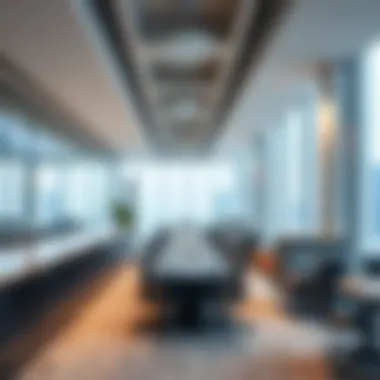
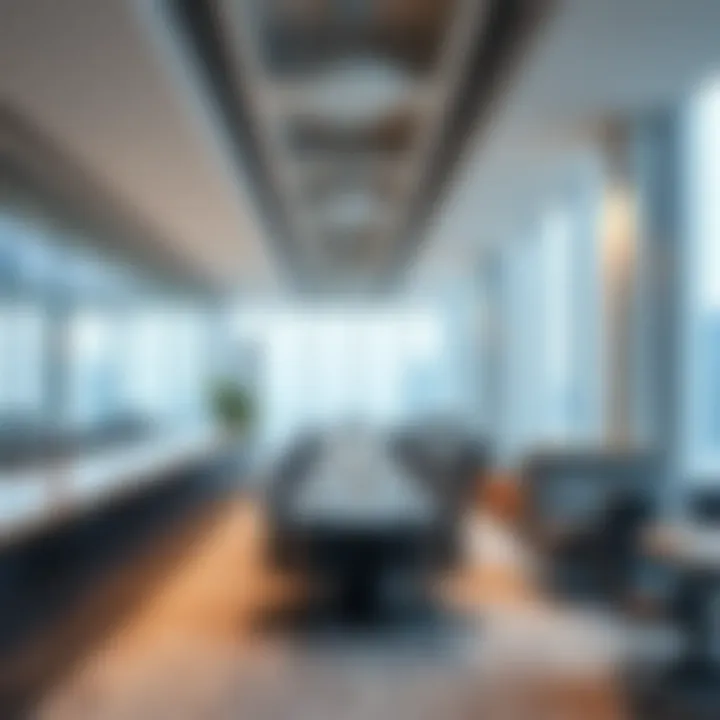
Intro
Al Quoz, an area known for its eclectic mix of art spaces and industrial hubs, has become a focal point for businesses seeking modern office environments that align with contemporary work culture. One company making waves in this vibrant locale is GMG. Its office spaces are not just a means to accommodate staff, but rather an intentional design reflecting the company's values and aspirations. This article aims to dissect GMG's office spaces, revealing their architectural merits, functionality, and the influence they have on employee performance. Through a visual exploration rich with photographs and insights, we will analyze how these spaces not only embody modern aesthetics but also effectively serve a workforce that thrives on collaboration and flexibility.
Understanding the design philosophy behind these offices can provide valuable lessons for investors, developers, and other stakeholders in the real estate sector. The integration of functional design with corporate identity is increasingly becoming a hallmark of successful workspaces. As we delve further, we will touch upon the rising trends in office design and how GMG's spaces adapt to meet the changing needs of businesses in Dubai.
Incorporating feedback from employees about their environment will also lend credence to the discussion, as employee well-being is a critical factor in overall productivity. We will highlight key trends in the market, discuss property prices, and explore potential investment opportunities in Al Quoz. By critically examining GMG's architecture, this analysis aims to provide an engaging narrative that both informs and inspires, encapsulating the essence of modern workplace design.
Prelude to GMG
Understanding GMG requires a closer look at its position within the broader context of Dubai’s vibrant business milieu. It’s not just about what GMG does, but how its operational ethos integrates with the contemporary landscape of corporate structures and employee dynamics. GMG stands out as a significant player, resonating through its innovative approach to office design and the influence it has on workplace culture. This section will delve into the essence of GMG, highlighting its unique characteristics and contributions.
Overview of GMG
GMG, or Gulf Marketing Group, operates primarily in sectors including retail, food and beverage, and sports and wellness. Established several decades ago, the organization has evolved into a multifaceted entity that adapts to market trends while maintaining a steady commitment to quality and customer satisfaction. Key brands under GMG's umbrella include Fitness First and the iconic Sun & Sand Sports.
The company's vision is rooted in not merely catering to the needs of its customers but also creating an employee-centric environment that fosters creativity and productivity. As the company expands, particularly with its presence in Al Quoz, understanding its operational framework provides insight not just into GMG's business strategy, but also its cultural philosophy.
This overview lays a solid foundation for analyzing how GMG has shaped its office spaces, reflecting its dynamic approach towards cultivating an effective work environment and ensuring employee satisfaction.
GMG's Role in Dubai's Business Landscape
In the pulsating heart of Dubai's business environment, GMG plays a pivotal role that cannot be overlooked. The company's adaptability to the shifts in market demands gives it an edge, allowing it to maneuver through challenges while capitalizing on opportunities. With a robust presence in Al Quoz, GMG has woven itself into the fabric of the locality, contributing significantly to the economic vibrancy of the area.
As Al Quoz emerges as a new frontier for business, GMG embodies the determined spirit of entrepreneurship that Dubai champions. Its office spaces reflect not just aesthetics but also function as hubs of innovation and collaboration. GMG’s commitment to sustainable practices and modern office design resonates well with the UAE's vision for a diversified economy.
"The evolution of GMG is a testament to the company's ability to align its objectives with the pulse of Dubai's economic growth while maintaining integrity in its operations."
In summary, GMG’s influence extends beyond mere profitability; it encompasses a commitment to community and cultural development. This section affirms the narrative that GMG is not just a business but a cornerstone of Dubai's corporate identity, setting a precedent for future enterprises in the region.
The Significance of Al Quoz
Al Quoz is not just another area submerged in the urban landscape of Dubai; it stands as a pivotal point in the region's business evolution. Recognized for its industrial roots, this district has transformed over the years, carving out a niche that touches various sectors, from art to commerce. Its redefinition as a vibrant business hub marks a significant shift, showcasing Dubai's adaptability and ambition.
Al Quoz as an Emerging Business Hub
In recent years, Al Quoz has emerged as a favorable business hub, attracting international attention for its unique blend of traditional industrial space and dynamic creative offices. Companies, both local and global, are recognizing the area's potential, setting up their bases amid its rugged charm. This transformation caters to a diverse range of industries, giving rise to a bustling environment brimming with opportunities.
"The reimagination of Al Quoz, from industrial wasteland to thriving business district, reflects the heart of Dubai's progressive ethos."
The diverse character of Al Quoz facilitates a melting pot of innovation, where businesses can communicate and collaborate without the constraints usually found in more saturated commercial areas. With the establishment of creative spaces and co-working environments, entrepreneurs and freelancers are finding their footing in this once-overlooked neighborhood. The unique blend of art galleries, performance spaces, and business operations suits a variety of corporate identities, lending the area an avant-garde spirit.
Location Advantages of Al Quoz
One cannot overlook the strategic advantages that Al Quoz offers to businesses. The location is key – it is centrally positioned in Dubai, sitting squarely between the bustling areas of Downtown and the prominent Dubai Marina. This centrality provides easy access to major highways, enabling seamless connectivity to and from other districts. Such accessibility enhances supply chain logistics, critical for companies reliant on swift transportation of goods.
- Proximity to Major Highways: Al Quoz's access to Sheikh Zayed Road and Al Khail Road means commuting is generally efficient, a huge plus for companies prioritizing employee well-being and time management.
- Cost-Effective Industrial Facilities: Compared to other districts, Al Quoz often offers more cost-effective leasing options, which appeals to startups and smaller businesses eager to minimize overhead costs.
- Diverse Workforce Pool: The area attracts a broad spectrum of talent due to its diverse and multicultural environment, essential for fostering innovation and catering to various markets.
In summation, Al Quoz is on the brink of becoming the heartbeat of Dubai’s evolving business landscape. Its strategic location combined with its emerging identity as a canvas for creativity provides an essential backdrop for GMG and other businesses aiming to thrive in today’s fast-paced marketplace.
Office Space Overview
Understanding the framework of GMG's office spaces is paramount, as an efficient office environment lays the groundwork for productivity and employee satisfaction. The design and layout significantly influence how employees work, collaborate, and thrive. In a city like Dubai, where innovation is the name of the game, the evolution of office spaces reflects the changing needs of businesses and the workforce.
More than mere physical structures, these spaces embody a philosophy marked by modernity and functionality. From sleek designs promoting creativity to vibrant areas facilitating interaction, each component serves a purpose that resonates with GMG’s corporate ethos. In tackling the complexities of modern work life, GMG not only invests in its workforce but also presents itself as a valuable player in Dubai's evolving business landscape. This overview sets the stage for understanding what makes GMG's offices in Al Quoz a focal point in the architectural and functional aspects of contemporary offices.
Design Philosophy of GMG's Offices
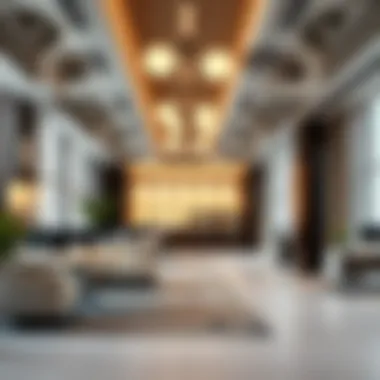

The design philosophy guiding GMG’s offices marries aesthetics with functionality. At its core, the aim is to create an environment that nurtures efficiency while inspiring creativity. The spaces are not just aesthetically pleasing; they are constructed with thoughtful layouts that encourage flow and accessibility.
The approach goes beyond merely placing walls or furniture. Strategically chosen colors, architectural features, and technological integrations all play a role in shaping employees' experiences daily. By prioritizing physical well-being alongside functional requirements, GMG ensures that the design reflects its commitment to fostering a supportive workplace culture.
Key Features of the Office Design
Open Workspaces
Open workspaces are a significant piece in GMG's office puzzle. This design encourages fluid interaction among employees, reducing barriers not only between individuals but also between departments. The key characteristic of an open workspace is its ability to promote collaboration.
In the context of GMG's office, this arrangement is so much more than just a layout choice; it stands as a social experiment encouraging teamwork and spontaneous brainstorming. Such spaces often result in higher levels of engagement and morale. However, while they foster communication, noise distractions could become a potential downside. Balancing these aspects is crucial to maintain productivity levels without sacrificing the collaborative spirit.
Collaborative Zones
Collaborative zones serve as designated areas where brainstorming and teamwork come to life. These spots are characterized by their unique and cozy setups designed to encourage the exchange of ideas, making them inviting for employees looking to gather creatively. The value of these zones lies not only in the physical design but also in the ethos they promote: a sense of community and shared purpose.
Having these areas within GMG’s office means that collaboration isn’t just about working side by side but involves creating a culture that nurtures relationships. The downside can be the risk of overcrowding, especially during peak hours. GMG must continually assess usage to ensure these collaborative zones remain effective and welcoming.
Private Meeting Rooms
Private meeting rooms provide an essential counterbalance to the communal nature of open spaces. These rooms are designed with soundproofing and technology integrations that cater to privacy needs without sacrificing accessibility. The hallmark of private meeting rooms is their ability to offer a focused environment where discussions can progress without outside distractions.
This feature is essential for GMG’s operations, ensuring that sensitive discussions take place within a secure setting. While they enhance focus and reduce disruptions, the challenge lies in ensuring these rooms are adequately utilized without creating a bottleneck that could limit collaborative efforts. Balancing availability with demand is a functional consideration that GMG must continually navigate.
"The design of office spaces isn’t just about aesthetics; it influences behaviors, interactions, and ultimately, productivity."
In essence, the structuring of GMG's office spaces caters to a holistic understanding of modern workplace demands. The blend of open workspaces, collaborative zones, and private meeting rooms illustrates a forward-thinking approach that aligns with the contemporary workforce's needs.
Impact of Office Design on Employee Well-Being
The environment in which employees work has a significant impact on their overall well-being, productivity, and satisfaction. Within the offices of GMG in Al Quoz, careful thought has been given to the design and functionality, making sure that it isn’t merely about aesthetics but rather about creating a nurturing space that supports the mental and physical health of its workforce. Understanding the dynamics at play is crucial for both employers and investors aiming to foster a productive workforce.
The interplay between physical space and employee performance cannot be overstated. For instance, an inviting, well-organized workspace can lead to enhanced focus and creativity. Offices that are thoughtfully designed can help minimize stress and fatigue, encouraging employees to feel more cared for and valued. To fully appreciate this relationship, we must break it down further into two key components: aesthetic appeal and ergonomics.
Aesthetic Appeal and Motivation
The visual aspect of a workspace can greatly influence an employee’s mindset. A well-decorated office not only reflects the company’s brand identity but also fosters a sense of belonging. Warm colors and inviting decor can instill a sense of comfort that inspires employees to engage more deeply with their tasks. For example, in GMG's office spaces, the use of natural light combined with thoughtful landscaping contributes to creating an uplifting atmosphere.
Survey results have shown that environments rich in stimulating and pleasant designs can spark motivation. Employees working in vibrant spaces often report higher levels of satisfaction and creativity. Thus, integrating personalized elements and artworks that resonate with the company culture can be beneficial in keeping the workforce engaged.
"A productive workspace is not just about how the office looks; it is about how it feels to those who inhabit it," says architectural psychologist Dr. Marina M.
Ergonomics in Workspace Design
While aesthetics are essential, the practical side of office design cannot be overlooked. Ergonomics plays a crucial role in ensuring that employees are physically comfortable, reducing the risk of strain or injury. GMG has prioritized ergonomic furniture options designed to cater to diverse needs, such as adjustable desks and supportive seating. This attention to detail demonstrates a commitment to employee welfare, which in turn can lead to lower absenteeism and higher morale.
Moreover, an ergonomic workspace encourages movement and flexibility. Employees who have access to collaboration areas paired with comfortable seating options can shift between tasks more efficiently. It creates a dynamic environment where individuals can choose how they work best, whether that involves brainstorming in a soft lounge chair or diving into focused work at a standing desk. The result is a workforce that feels more in control of their productivity.
In summary, the design of GMG's offices in Al Quoz is a testament to the significant impact that well-thought-out aesthetics and ergonomic principles can have on employee well-being. For companies looking to boost their workforce’s creativity and morale, making these elements a priority is not just a recommendation; it's a business necessity.
Visual Analysis of GMG Office Photos
The visual analysis of GMG's office photos serves as a lens through which we can evaluate not just the aesthetic appeal of the offices in Al Quoz but also their functionality as work environments. This deep dive allows stakeholders, including investors and business leaders, to appreciate how the design choices resonate with the company’s overarching goals.
Interior Layout and Space Optimization
The interior layout of GMG's office spaces is pivotal in fostering an environment that encourages productivity. From open work areas to organized private spaces, every element in the layout is crafted to maximize efficiency. For instance, the placement of collaborative zones encourages spontaneous brainstorming sessions, while soundproof private meeting rooms provide a refuge for focused discussions.


Furthermore, the use of modular furniture not only caters to various working styles but also allows for quick reconfigurations based on team needs. This adaptability means that the design is not static; it shifts to reflect the ever-changing demands of the workforce, thus optimizing the available space.
Color Schemes and Their Influence
Color plays a significant role in establishing the mood of a workplace. GMG's choice of color schemes deliberately reflects their brand essence while also enhancing the workplace atmosphere. Soft blues can instill a sense of calm, which is vital in high-stress environments, while vibrant yellows may invigorate and inspire creativity among employees.
Research indicates that color can influence focus and productivity. Therefore, careful consideration has been given to how colors interact with natural light in the space. The balance between warmth and cool tones is achieved through the strategic placement of windows, allowing sunlight to accentuate the chosen hues, thereby creating an inviting ambiance.
"In the world of office design, every color choice tells a story, shaping not only the physical space but also how employees feel and perform within it."
Emphasizing the importance of aesthetic elements, GMG ensures that the visual aspects of their offices are reflective of their corporate culture. The overall combination of layout and color creates a polished yet comfortable environment, boosting employee morale and productivity.
By delving into the visual aspects of GMG's office spaces in Al Quoz, we see that there is much more at play than meets the eye. It’s about crafting a space that embodies the essence of innovation while supporting the well-being of its occupants.
Sustainability Practices in Office Design
Sustainability is more than just a buzzword in today’s world; it’s a necessity. Especially in Al Quoz, where industrial growth meets the call for greener solutions, companies like GMG lead the way. Emphasizing sustainable practices in office design not only reflects a company's commitment to the environment but also showcases an understanding of evolving employee needs.
Eco-Friendly Materials and Construction
In GMG's office spaces, the use of eco-friendly materials is paramount. By selecting sustainable resources, such as recycled steel and low-VOC (Volatile Organic Compounds) paints, GMG ensures that their workspace is both functional and environmentally friendly. Not just a trend, these materials are crucial for long-term viability. For instance, using bamboo flooring not only reduces carbon footprints but also provides a unique aesthetic touch. The flexibility and durability of these materials lend themselves well to various designs, catering to a modern office's needs.
Another vital aspect lies in construction techniques. The focus on innovative building methods, such as modular construction, allows for a reduced waste output during the development phase. Streamlined processes not only minimize expenses but cut down unnecessary waste – a significant consideration in any sustainable endeavor. This way, GMG contributes to a greener community while maintaining high standards in its office spaces.
Energy Efficiency Strategies
Being energy-efficient is another corner stone of sustainable office design. GMG has implemented advanced strategies like smart lighting and temperature control systems. These technologies not only improve comfort but significantly lower energy consumption. For instance, intelligent building systems can adjust heating and cooling based on occupancy, ensuring resources are utilized wisely. When you consider the blazing heat of Dubai, such adaptations are a game changer.
Incorporating renewable energy sources also plays a significant role. GMG’s use of solar panels on rooftops harnesses the abundant sunlight available in Dubai. This not only cuts energy costs but positions GMG as a forward-thinking corporation that cares for the planet.
While sustainability practices yield immediate benefits, the long-term advantages can’t be overstated. Companies that prioritize eco-friendly designs are often seen as attractive workplaces. Employees today value their work environments and, with a growing focus on health and well-being, a sustainable workspace can foster higher motivation and engagement levels.
"Sustainability isn’t just about doing the right thing; it’s about staying relevant and competitive in a rapidly changing world."
By embracing these strategies, GMG not only elevates the quality of their office space but sets a standard within the industry. Their innovative choices resonate with an informed, conscientious audience, making them a role model for corporations eyeing sustainability in their operations.
Corporate Culture Reflected in Office Design
Understanding how corporate culture finds expression in office design is crucial to appreciating the overall effectiveness of a workplace like GMG in Al Quoz. This environment not only houses employees but also embodies the values and ethos of the organization. A well-thought-out office space can enhance collaboration, drive innovation, and uplift employee morale, which are all essential elements of a thriving corporate culture.
Space that Fosters Collaboration
In the modern workplace, the physical environment plays a pivotal role in shaping interpersonal connections. At GMG, the office design is intentionally crafted to dismantle barriers between teams. Open workspaces, complemented by collaborative zones, encourage employees to engage freely, fostering a spirit of teamwork. When colleagues can converse without the constraints of walls, creativity flourishes. This design approach supports a culture of idea-sharing, where input from all levels is not only encouraged but expected.
Some specific design elements at GMG that reflects this philosophy include:
- Flexible Seating Arrangements: By offering varied seating types—like cozy lounges and communal tables—employees have the freedom to choose where and how they work best.
- Breakout Areas: Spaces with a casual feel equipped with whiteboards and tech setups allow teams to brainstorm away from their desks, enhancing creativity.
- Visual Connectivity: Seeing and being seen can boost motivation. Glass-walled conference rooms allow others to observe engagement in meetings without intruding.
These facets of design not only create a friendly atmosphere but also align closely with GMG’s values of collaboration and openness.
Incorporating Technology into Workspaces
The infusion of technology in office design cannot be overlooked in today’s digital age. GMG emphasizes smart workplace solutions that integrate seamlessly into the daily workflows of its employees, thus respecting both their time and potential for productivity. Incorporating tech is about more than just convenience; it’s about creating a work environment that feels intuitive.
Key technologies that are a part of the office landscape include:
- Smart Boards: These are not just for presentations but encourage active participation and real-time feedback, making meetings more dynamic.
- Collaboration Software: Tools like Slack and Microsoft Teams are integrated into workflows, ensuring that communication remains fluid regardless of where employees are situated in the office.
- Automated Controls: Utilizing smart lighting and climate control systems can actually enhance comfort levels, allowing employees to adapt their surroundings according to their preferences.
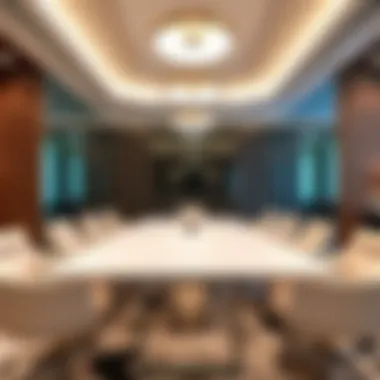
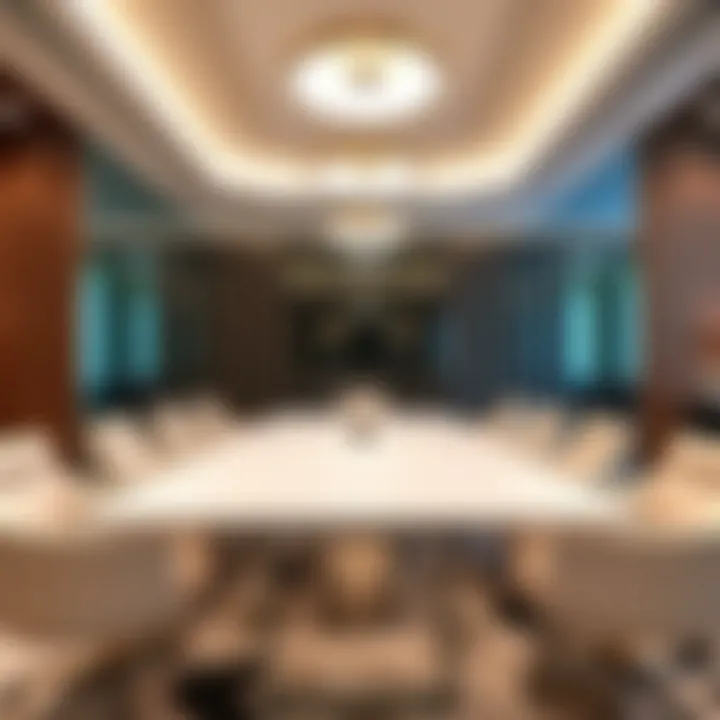
In doing so, GMG’s spaces are not merely offices. They are ecosystems that adapt to the needs of their users, making technology both a lifeline and a support system for everyday tasks.
"A well-designed office can serve as a catalyst for company culture, tailoring the space to reflect not just what the company does, but who they are."
This intersection of space and technology nurtures a corporate culture that values adaptability and innovation, contributing to GMG’s reputation as a forward-thinking organization within Dubai’s landscape.
Challenges in Developing Functional Office Spaces
Creating a functional office space is not just about putting a few desks and chairs in a room. It's an intricate dance of planning that brings together aesthetics and practicality. In a landscape as vibrant as Al Quoz, with its unique architectural style and diverse businesses, GMG's offices serve as a case study in this endeavor. They shine a spotlight on the multifaceted challenges of space development, showcasing how each requirement must be addressed to foster an enriching environment for employees.
Key elements come into play when businesses strive to create office spaces that not only look good but also function well. For instance, the overall layout needs to facilitate workflow, while also being visually inviting. This brings us to the first challenge:
Balancing Aesthetics and Functionality
In the world of office design, aesthetics often battle functionality for the spotlight. One of the primary challenges in developing GMG's office spaces was ensuring that they were visually appealing yet practical.
- Design coherence: A sleek, modern look can be tempting, but if it disrupts employee productivity, it defeats its purpose. For example, an open floor plan may look chic, but it can also lead to noise distractions and hinder focus if not thoughtfully implemented.
- Material choices: Selecting materials that are both durable and aesthetically pleasing is another crucial consideration. A polished wood finish might add a touch of class, but if it doesn’t withstand daily wear, that could lead to costly replacements.
- Lighting: Natural light is celebrated for its role in enhancing mood and productivity, yet it must be complemented by effective artificial lighting solutions. Too much glare or inadequate illumination can turn a design triumph into a practicality fail.
Achieving the right balance often means involving architects, interior designers, and potential employees early in the process to gather input on both visual and functional needs. The goal is to create spaces that people love to spend time in without compromising on usability or flow.
Adaptability in Office Spaces
In a fast-evolving business environment, adaptability is a critical factor in the design of office spaces like those of GMG. As trends shift and business needs change, so too must the offices themselves.
- Flexibility: The demand for flexible workspaces has skyrocketed, given the increase in remote working arrangements. Creating areas that can be easily rearranged for various tasks—from group brainstorming sessions to quiet retreats—can increase efficiency and foster collaboration. Designating a multifunctional space, capable of transforming from a meeting area to a lounge, exemplifies this adaptability.
- Technology integration: With technology continuously advancing, an adaptable office must also incorporate tech solutions that can evolve. It's no longer sufficient to have a one-size-fits-all approach; modular tech setups that can grow alongside the company become essential.
- Employee feedback: Lastly, design must include mechanisms for continual feedback. What might work well for employees today could fall flat in a year. Developing spaces with employee input ensures spaces don't become stale.
In essence, the journey towards developing functional office spaces like those at GMG in Al Quoz is rife with challenges that require careful planning and foresight. The nuances between aesthetics and functionality, coupled with the need for adaptability, make this task both daunting and rewarding. Businesses that embrace these challenges are more likely to create environments that inspire innovation and productivity.
Future Trends in Office Design
As we consider the evolution of office spaces, the spotlight now falls on the future trends shaping their design. The significance of this topic lies not just in aesthetics but in how these spaces can drastically impact both employee productivity and overall business success. It's no surprise that adaptability, innovation, and functionality take center stage in modern work environments. When it comes to GMG's offices in Al Quoz, looking ahead is just as crucial as understanding the present design.
Influence of Remote Work on Office Spaces
Over the past few years, remote work has transitioned from a fleeting trend to a staple in many industries. Companies worldwide are re-evaluating how to utilize their physical office spaces. Culture and workflow have become more flexible, necessitating a rigorous reassessment of traditional layouts. GMG, as a progressive company, knows that addressing this change is essential.
- Hybrid Work Models: The idea of work from anywhere has led to hybrid models, which blend both home and office environments. GMG can benefit from creating dedicated spaces within their offices for collaborative projects, alongside areas for remote workers visiting sporadically.
- Technological Integration: Modern office design now requires seamless technology. High-speed internet and video conferencing facilities are vital. Designing spaces that support this tech can foster a more connected and engaged workforce. GMG's offices can incorporate advanced tech hubs that facilitate both in-person and remote interactions, breaking down traditional barriers.
"Adapting to remote work trends is not merely an option but a necessity for companies aiming to stay ahead of the curve."
Innovative Concepts for Modern Workspaces
In light of these developments, innovative concepts manifest in various creative ways. Interior design goes beyond mere decor: it’s about integrating functionality with a vision.
- Biophilic Design: This approach aims to connect people with nature, enhancing well-being in the workspace. GMG could, for example, introduce living walls or indoor gardens, which have been shown to improve air quality and reduce stress levels.
- Flexible Spaces: Transforming traditional office layouts into adaptable spaces encourages creativity and collaboration. Modular furniture allows for quick reconfiguration, depending on meeting needs or team size. GMG's strategy to incorporate such flexibility might foster a culture of seamless teamwork.
- Wellness Areas: Employees today seek balance. Creating dedicated zones allows for informal gatherings or moments of respite. GMG can design spaces that cater to both active breaks and relaxation, displaying their commitment to employee well-being.
Closure
The conclusion of this article holds significant weight, as it encapsulates the exploration of GMG's office spaces in Al Quoz, honing in on effective design principles that enhance functionality, promote employee well-being, and align with contemporary business needs.
Summing Up the Importance of Effective Design
In today’s competitive landscape, the significance of effective office design cannot be overstated. More than mere aesthetics, it acts as a catalyst for productivity and creativity among employees. GMG's offices exemplify this concept through carefully curated work environments that reflect a modern workforce's demands.
Consider the following key points that underscore the relevance of thoughtful office design:
- Enhancing Collaboration: Open workspaces designed by GMG emphasize collaborative efforts. With fewer barriers, employees can share ideas more freely, leading to innovation and improved project outcomes.
- Promoting Well-Being: Ergonomic considerations in design can significantly boost employee health. By incorporating proper seating and natural light, GMG’s offices ensure that the physical comfort of employees is a priority, which in turn fosters mental well-being.
- Sustainability: The use of eco-friendly materials not only reflects corporate responsibility but also resonates with modern clients and consumers who are becoming increasingly aware of environmental issues. These spaces embody the blend of style and substance, drawing in talent and clients alike.
- Adapting to Change: Flexibility in design allows office spaces to adjust to changing work patterns, such as remote work trends. It gives organizations room to grow and evolve without the need for massive overhauls.
Ultimately, as we wrap up our exploration, it’s clear that the effectiveness of GMG's office design goes hand in hand with the overall performance of its employees. In a city as dynamic as Dubai, where businesses are rapidly evolving, the importance of creating spaces that not only function efficiently but also inspire cannot be neglected. Investing in such thoughtful design is akin to investing in the future of the company itself, as they directly influence productivity, employee satisfaction, and corporate image.
"The design of the workplace is a reflection of a company’s culture and its core values. Effective office design creates an environment where people thrive."
For further exploration of forward-thinking office designs, resources such as Britannica (www.britannica.com) or professional insights on Reddit can enrich understanding of workplace trends and their impact on organizational success.















